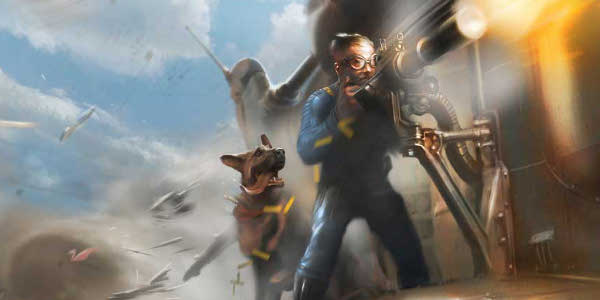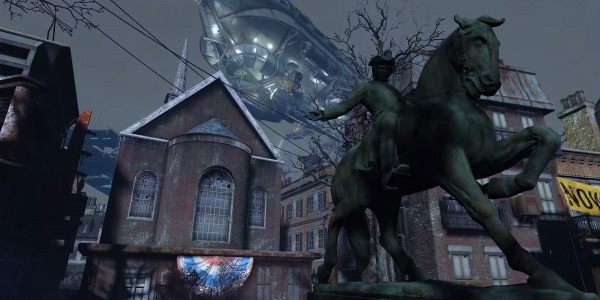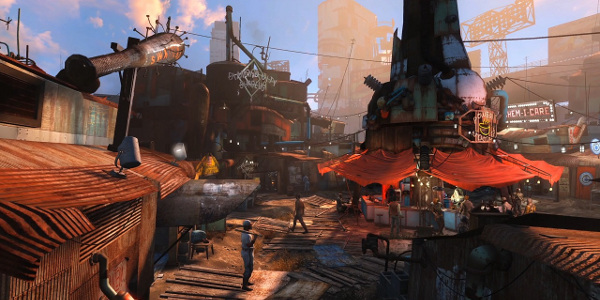
Before Fallout 4's launch, I joked that you could write an accurate review of the game before you even played it if you've experienced past Bethesda role-playing games. This turned out to be mostly true.
Over time, I've come to expect the following things from a Bethesda RPG:
- Expansive open-world with tons of quests and Easter eggs to find.
- Exciting, first-person combat that gets repetitive over time.
- Clunky user interface.
- Wooden characters.
- Bugs.
Fallout 4 ticks each of those boxes. Still, there are enough unexpected changes in the game that it doesn't just feel like Fallout 3 with Massachusetts references.
This latest Fallout adventure takes us to the Commonwealth, the post-apocalyptic remains of the Boston metropolitan area. It's by far the most striking setting for a Fallout game yet because it manages to look ruined but beautiful at the same time. There's rubble everywhere but it's still a colorful place with grand buildings and gorgeous sights.
Visuals are really important for a game like this because aimless exploration is the most fun part. You're walking to a quest marker when suddenly some building on the horizon catches your idea. You decide to stop there quick and that detour turns into a two-hour treasure hunt or kicks off a quest that will take you across the entire Commonwealth. By littering the landscape of Fallout 4 with so many visually interesting locations, Bethesda coaxes the player into wandering.
It's common in Bethesda games that this free roaming is more memorable than the central quest line. That's true of Fallout 4 as well, though the central storyline can be really enjoyable. Your journey has huge implications for the people of the Commonwealth but what I think really sells it is the deeply personal plot at its core. You keep playing not so much because you want to see what faction ends up on top but because you want to see the hero - who, in a first for the series, has voice acting - get some closure.
There's one disappointing aspect to the hero, though: the player can't make him all that evil. With most quests, it feels like you're restricted to the same range of morality as Mass Effect's Commander Shepard: you'll kill the bad guys either way, but you can be a dick about it if you want. I'm a Lawful Good player generally so it didn't matter for my play-through but the lack of interesting evil choices could be very disappointing to someone who spent previous games eating people and wiping out towns.
Your Daily Blend of Entertainment News

While you'll occasionally meet some friendly faces in your travels, most people and animals living in the wasteland will attack you on sight. The combat once again plays out in real-time, though the V.A.T.S. system lets players occasionally halt the action to queue up attacks at specific parts of enemies. Performing these called shots requires Action Points, which replenish over time. Using V.A.T.S. to queue up shots is easier than manually aiming and will save you a lot more ammo in the long run.
My strategy in Fallout 3 was to use up my Action Points and then run away until they recharged so I could queue up another series of shots. If I got hurt, I'd just pause the action by bringing up the inventory screen and use healing items to get back to full HP. Bethesda tried to break this common cycle with a couple changes. V.A.T.S. now merely slows down the action rather than pausing it altogether so enemies can still hit you. Furthermore, sprinting expends Action Points now so fleeing now makes counterattacking harder. Healing, meanwhile, occurs over time rather than instantaneously. The system's still not perfect (I'd love to see players limited to just their quick slots in combat, for example) but Bethesda has at least pointed the boat in the right direction.
Maybe the biggest issue with the combat is that it's not deep enough to shoulder most of the gameplay. Most quests in the game ask you to go somewhere and kill a bunch of enemies. This is most challenging in the early hours when you don't have a companion and you're struggling to find decent guns and ammo. However, once you've got a well-rounded set of long-range and short-range weapons, you're prepared for pretty much anything the game will throw at you. Your strategy won't change much, aside from needing to hug cover more often.
For the most intense fights, you can use a suit of Power Armor. You'll get access to a suit early on and can find others spread throughout the world. These giant suits of armor are no longer worn like normal gear. Instead, you climb inside them like a vehicle. Reinventing Power Armor as a limited-use item allowed Bethesda to make it much more powerful. You'll have significant damage reduction and strength while inside the Power Armor so you'll feel a bit like a super hero. Power Armor requires Fusion Cores, a resource you'll rarely find through your travels, but to be honest my use of the armor was limited more by interest than by that resource. It's fun to play Iron Man from time to time but it was so rare that I needed the extra protection. I often left the armor at home so I wouldn't have to worry about leaping in and out every time I wanted to pick a lock or hack a computer.

The newest part of Fallout 4 is the building system. After a settlement is established, you'll help construct all the facilities. You need to make sure that the settlers have enough food, water and beds. Then you have to construct turrets, guard posts and other defenses to ensure that this village will be safe from raiders or other undesirables. You get materials for all of these building projects by collecting random junk throughout the world.
The building system, as it exists now, is pretty awkward. There's no way to look at an overall tally of your building materials. Unless your character has a high Charisma, the different settlements won't share materials so you'll have to mule them from one to the next. To build something, you need to walk to the workshop, then walk to the location you want to build, dig through the workshop menu to find what you want to build, and then rotate and move the object into the proper position. The process would be about ten times shorter if you could just manage your construction from a top-down view. On top of all that, most of the structures you can build just look like garbage bolted to more garbage.
Don't get me wrong: it can be fun to build no matter how time-consuming it is. It's gratifying to turn an abandoned drive-in movie theater or camp ground into a teeming village. The building system gives purpose to the random objects strewn throughout the world as well. The feature feels like it's been stapled onto a game that's really not designed for it, though. I'm hoping that modders can smooth out the rough edges and add some more attractive options for builders.
If you thought Fallout 4 would fix all the problems from Bethesda's past RPGs, you're going to be disappointed. They're still the developer that can build miles of fascinating landscapes but forget to give you a way to locate a lost companion in that vast wilderness. When you play their games, you know what to expect: a world you can lose yourself in as long as you can look past limited combat and some other shortcomings. If you're comfortable with that trade-off, you're going to have a hell of a time.
Platforms: PC (reviewed), Xbox One, PS4
Developer: Bethesda Game Studios
Publisher: Bethesda Softworks
ESRB: Mature
Rating:

Staff Writer at CinemaBlend.

